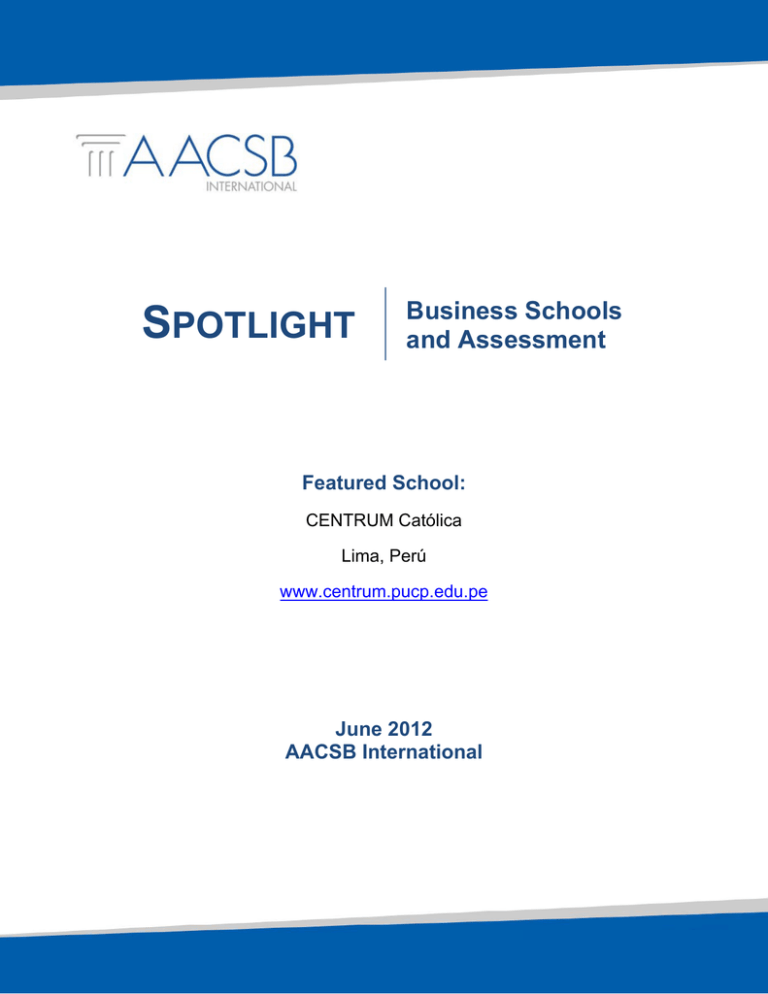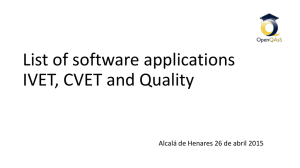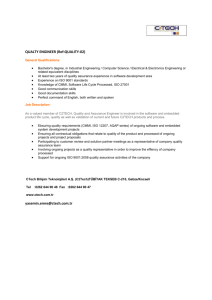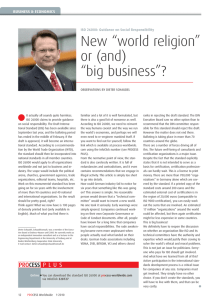
SPOTLIGHT
Business Schools
and Assessment
Featured School:
CENTRUM Católica
Lima, Perú
www.centrum.pucp.edu.pe
June 2012
AACSB International
SPOTLIGHT | Business Schools & Assessment
CENTRUM Católica | 2
CENTRUM Católica: ISO Certification and Assurance of Learning
In 2003, only two years after its founding, CENTRUM Católica, the business school of Pontificia
Universidad Católica del Perú, achieved the distinction of becoming the first business school in Latin
America to be certified in accordance with the standards of the International Organization for
Standardization (ISO).1 In 2010, CENTRUM Católica (CC) achieved another first by becoming the first
Peruvian business school to attain AACSB accreditation. According to CC’s Deputy Director General,
Professor Beatrice Avolio, these twin accomplishments are a reflection of the quality assurance strategy
that has been integral to the academic culture of the school since its founding.
During an interview with AACSB researcher R. Colin Nelson, Professor Avolio laid out some of the
history, challenges, and successes her school has met with over the years in maintaining its highly
rigorous quality assurance regimen, including the ways in which that regimen’s various components
complement one another to the benefit of CENTRUM Católica’s assurance of learning (AoL) processes,
as well as the school’s stakeholders:
R. Colin Nelson (RCN): For those of our members who may be unfamiliar with ISO standards, can you
elaborate a bit on what they cover, and how that process works?
Beatrice Avolio (BA): Certainly. ISO 9001:2008 certification (the 2008 version of the ISO 9001 global
quality management standards) is used to establish, document, implement, maintain and improve an
organization's quality management system (QMS).2 ISO standards can be applied to an educational
institution, a private company, a public sector organization, NGO or any organization that provides a good
or service to a client. They cover all aspects of managing quality assurance, including the continual
determination of customer requirements, monitoring fulfillment of those requirements, and correction of
any problems that may arise. The certification of CENTRUM Católica’s QMS pertains to all degree and
non-degree programs and administrative processes. As a product of certification, CC has developed and
formalized a wide-reaching series of processes that are based on the ISO 9001:2008 standards.
In 2003, CENTRUM Católica was the first business school in Latin America that was certified according to
ISO 9001:2000 standards, and in October 2009, CC once again was the first business school in Latin
America certified under the new ISO 9001:2008 standards by the Lloyds Register Quality Assurance, an
ISO certification body. The maintenance of certification requires semi-annual external audits by such a
body, and progress must be shown against any prior instances of non-compliance with ISO standards.
The renewal of certification every three years requires resolving any and all outstanding instances of noncompliance.
© AACSB International. All Rights Reserved.
SPOTLIGHT | Business Schools & Assessment
CENTRUM Católica | 3
In general, ISO provides a scheme and the discipline to define and (through the audits) to enforce
CENTRUM Católica’s AoL procedures. According to ISO 9001, the validation of the design and
development of programs must be performed according to a plan, to ensure that the resulting product is
capable of meeting the requirements for its specified application or intended use. Records must be kept
of the results of the validation and of any action necessary. CC conducts student satisfaction surveys for
the courses offered, teaching methods and evaluation systems in order to find opportunities for
improvement in the teaching – learning process.
RCN: How did CENTRUM Católica come to take the decision to pursue ISO certification initially? Why
was it felt to be important to CC’s quality assurance strategy?
BA: Quality assurance and continuous improvement are matters of utmost importance for CENTRUM
Católica, which is highly committed to continuous improvement through the implementation of a quality
assurance system based on the ISO 9000 standards. ISO certification is part of an integrated quality
assurance strategy at CC. The decision to pursue ISO 9001 certification was taken shortly after
CENTRUM Católica’s founding in 2001, when it was felt that ISO would provide a set of standards to
support CC’s quality assurance strategy, as well as an assurance to its stakeholders of the quality of its
educational and other services.
RCN: Does CENTRUM Católica find synergy between ISO and AACSB standards and processes? If so,
where?
BA: Yes, of course, there are clear synergies between ISO and AACSB standards, particularly AACSB’s
Standard 4 on Continuous Improvement Objectives and Standard 15 on Curriculum Management. With
respect to Standard 4, since CC earned its first ISO 9001:2000 certification, the commitment to
continuous improvement has been evident in each of our activities and processes, following the
methodology of process-based approach which seeks to develop, implement and improve the
effectiveness of Quality Management System to increase customer satisfaction by meeting their
requirements. We have a policy, objectives and a Quality Manual that provide guidelines to continuously
improve the effectiveness of our Quality Management System. These policies involve the programming of
internal and external audits where improvement opportunities are identified, which originate corrective
and preventive actions, data analysis and management review to ensure compliance with our quality
objectives.
For Standard 15, Chapter 7.3 of ISO 9001 provides guidelines for product design and development. CC
programs follow the design and development structure proposed in ISO 9001, which in the "Control of
Changes in Design and Development" stage indicates that the changes are to be reviewed, verified and
© AACSB International. All Rights Reserved.
SPOTLIGHT | Business Schools & Assessment
CENTRUM Católica | 4
validated, as appropriate, and approved before being implemented. The review of design and
development changes must include the evaluation of the effect of the changes in the constituent parts,
and the product already delivered. In that sense, CENTRUM Católica has elaborated the procedure for
updating curricula with the purpose of regulating the process of assessing and modifying the curricula. It
consists of the Council for the evaluation of curricula and stakeholders (students, alumni, business
partners, academic partners, International Advisory Board, faculty and environmental stakeholders) for
the evaluation and modification of curricula.
Likewise, many other AACSB standards are based on the development of quality assurance processes,
and so, have significant synergies with ISO 9001 quality assurance standards. For example, indicators
have been created that take into account AACSB standards for CENTRUM Católica’s ISO Quality
Management System.
RCN: Can you give any specific examples of how the integration of ISO processes with Assurance of
Learning (AoL) has resulted in quality improvement (i.e., “closed the loop”) at CENTRUM Católica?
BA: Assurance of Learning at CC is part of the wider policy on quality assurance, of which ISO is also an
integral part, and which has been developed for accomplishing and maintaining high-quality academic
standards of education through a continuous improvement policy. CENTRUM Católica has established
procedures for the design, development and management of academic programs according to the
standards of ISO 9001:2008. In addition, we have established procedures for the measurement, control
and evaluation of the academic programs according to the ISO standards that include feedback from the
business community, faculty, and students.
CENTRUM Católica has developed a series of four ISO documents that define the procedures for the
evaluation of AoL for different programs, list the courses and assignments where specific skills and
knowledge are to be evaluated for each program, and specify how the results are to be reported. AoL is
about accomplishing and maintaining high-quality academic standards of education through a continuous
improvement policy, including:
Optimizing the quality of the DBA program through guidelines proposed by AMBA accreditation.3
Optimizing the quality of the programs through the strategic guidelines proposed by the AACSB
standards.
Improving the curriculum of the MBA and DBA programs.
AACSB standards directly complement each of these procedures, which are based on continuous
improvement and the management of quality. Among the key documents that are directly related to
AACSB standards are:
© AACSB International. All Rights Reserved.
SPOTLIGHT | Business Schools & Assessment
CENTRUM Católica | 5
Policy on quality
Matrix of indicators of the quality goals
Manual on quality
Procedures, documents and records supporting all stages of the CC macro-process and AACSB
standards:
o
Marketing and sales
o
Admission
o
Teaching and learning
o
Faculty
o
Administration
o
Academic Quality
o
Infrastructure, logistics and technology
CENTRUM Católica’s Assurance of Learning Committee also actively participates in ISO quality
assurance processes. The Director of our Office of Accreditations, Continuous Improvement and Quality
Assurance (OCAMECA) is a member of the AoL Committee. As Director of OCAMECA, he also
supervises ISO processes.
Once a year, the AoL Committee revises and verifies the adequate goals, objectives and rubrics of the
Outcome Assessment Plan. The committee schedules the dates for when to collect evidence during the
year in order to ensure the programs’ quality. The plan is completed according to the curriculum of
programs. After the evidence is collected, the evidence is revised using rubrics and reports of the analysis
are prepared for the AoL Committee. At another yearly meeting, the AoL Committee evaluates the
Outcome Assessment Plan results and implements improvements.
RCN: In your opinion, did CC’s participation in ISO certification enhance your school’s ability to pursue
AACSB accreditation successfully?
BA: Yes, the development of formal processes under ISO quality management standards was a key to
CENTRUM Católica’s preparation for our successful pursuit of AACSB accreditation. The implementation
of a system of continuous improvement, including the documentation, registration and continuous
improvement of the processes used in CC’s operations, prepared CENTRUM Católica for the “culture of
continuous improvement” that is at the heart of AACSB’s accreditation standards.
CENTRUM Católica’s Quality Management System includes all the requirements for international
accreditation, and supports the accomplishment of accreditation standards. The key performance
indicators are:
© AACSB International. All Rights Reserved.
SPOTLIGHT | Business Schools & Assessment
CENTRUM Católica | 6
(a) Academic program quality—Measured through innovation in program content, global perspectives of
the courses and business community impact.
(b) Learning outcomes—Measured through the achievement of learning objectives in terms of
competencies.
(c) Faculty member performance—Measured through qualifications, intellectual contribution outcomes,
internationalization, training and student support.
(d) Administrative and infrastructure—Measured in terms of administrative procedures and installed
capacity of building, solution and facility requirements in support of faculty members, students and
staff.
CENTRUM Católica’s 160 ISO regulations are a key to our quality assurance system, which monitors
academic and administrative procedures, for example: Procedure for the Control of Non-Compliance,
Procedure for the Evaluation of Client Satisfaction, Procedure for the Selection of Suppliers, Procedure
for the Management of In-House Programs, Procedure for the Administration of Final Exams.
Furthermore, CC is in the process of working towards meeting ISO14000 standards, which are related to
environmental management, i.e., minimizing how our operations negatively affect the environment.
Here is a graphic representation of the QMS processes at CC and how they fit together:
The Quality Management System of CENTRUM Católica is completely reviewed, verified and approved
on a continual basis:
Every three years, Lloyd’s Register Quality Assurance conducts a comprehensive audit of the
complete Quality Management System and renews its certification.
© AACSB International. All Rights Reserved.
SPOTLIGHT | Business Schools & Assessment
CENTRUM Católica | 7
Lloyd’s Register Quality Assurance verifies the effectiveness of the QMS and provides
recommendations for continuous improvement every six months through external audits.
In addition, internal auditors conduct internal audits every two months.
RCN: I’ve heard that ISO certification can be costly. Is there a budget allocation for assessment
processes at your school? If so, how is it determined?
BA: Yes, CENTRUM Católica has a budget allocation for assessment processes. The Office of Academic
Excellence, Continuous Improvement and Accreditations (OCAMECA) has nine full-time professional
employees that are dedicated exclusively to the maintenance of ISO certification and AACSB
accreditation standards. The maintenance of ISO certification involves the continuous monitoring,
improvement and documentation of the processes used at CENTRUM Católica, as well as the
coordination of the semi-annual external audits and the internal audits every two months.
Acknowledgements: AACSB International is grateful for the assistance of Professor Beatrice Avolio,
Deputy Director General and Head of the Department of Finance and Accounting at CENTRUM Católica.
© AACSB International. All Rights Reserved.
SPOTLIGHT | Business Schools & Assessment
CENTRUM Católica | 8
End Notes
1
CENTRUM Católica. (2012) International and Institutional Relations / Certification ISO 9001: 2008 web page. Electronic document, http://centrum.pucp.edu.pe/en/contenido.php?2932/centrum_catolica/certification_iso_9001_2008_2.html, accessed April 18, 2012. 2
Praxiom Research Group, Ltd. (2012) “ISO 9000, 9001, and 9004: Plain English Definitions.” Electronic document, http://www.praxiom.com/iso‐definition.htm#Quality%20management%20system%20%28QMS%29, accessed April 19, 2012. 3
In addition to AACSB accreditation and ISO certification, at this writing CENTRUM Católica also maintains accreditation by AMBA, EQUIS, and IACBE. See: Nelson, R. Colin. (2012) “How Much is Enough?” AACSB Data and Research Blog, January 25, 2012. Electronic document, http://aacsbblogs.typepad.com/dataandresearch/2012/01/how‐much‐is‐enough.html, accessed April 18, 2012. © AACSB International. All Rights Reserved.






